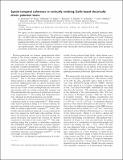Spatio-temporal coherence in vertically emitting GaAs-based electrically driven polariton lasers
Abstract
We report on the implementation of a GaAs-based, vertically emitting electrically pumped polariton laser operated at cryogenic temperatures. The structure consists of a high quality factor AlGaAs/AlAs microcavity (Q=15 000) with two stacks of four GaAs quantum wells and features a Rabi splitting of 11 meV. Polariton lasing manifests by a clear threshold in the input–output characteristics of our device with a sharp drop in the emission linewidth and a continuous blueshift of 0.7 meV above threshold with increasing injection current. We measure spatial and temporal coherence of our device in the condensed phase by utilizing interference spectroscopy. Our results clearly demonstrate that electrically driven polariton lasers have promise as monolithic polaritonic sources of coherent light.
Citation
Suchomel , H , Klaas , M , Betzold , S , Gagel , P , Beierlein , J , Klembt , S , Schneider , C & Höfling , S 2020 , ' Spatio-temporal coherence in vertically emitting GaAs-based electrically driven polariton lasers ' , Applied Physics Letters , vol. 116 , no. 17 , 171103 . https://doi.org/10.1063/5.0007456
Publication
Applied Physics Letters
Status
Peer reviewed
ISSN
0003-6951Type
Journal article
Description
Authors gratefully acknowledge the financial support by the state of Bavaria, the DFG within the projects Schn1376-3.1 as well as KL3124/2-1 and the Wurzburg-Dresden Cluster of Excellence on Complexity and Topology in Quantum Matter - ct.qmat. S.H. is grateful for funding received within the EPSRC Hybrid Polaritonics programme grant (EP/M025330/1).Collections
Items in the St Andrews Research Repository are protected by copyright, with all rights reserved, unless otherwise indicated.

